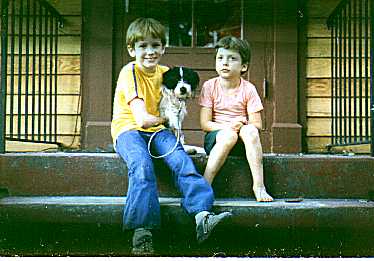 Sure enough, it works. Here's a sample, a 35 mm
slide scanned at 300
dpi and saved as a lo-res jpg:
Sure enough, it works. Here's a sample, a 35 mm
slide scanned at 300
dpi and saved as a lo-res jpg: Betty Winsett wrote in to say that she'd found a simple method for scanning slides using a fluorescent flashlight as a light source. She said she just lays the flashlight on the slide and scans away.Using a Fluoroescent Flashlight to Scan 35 mm Slides on a Flatbed Scanner
Here's her web page on the subject: http://www.afn.org/~afn11300/slides.html
Naturally I dug out the little Radio Shack model 61-2734A dual-mode flashlight (incandescent & fluorescent) that's been in a drawer for several years, popped in three new C cells, and gave it a try.
 Sure enough, it works. Here's a sample, a 35 mm
slide scanned at 300
dpi and saved as a lo-res jpg:
Sure enough, it works. Here's a sample, a 35 mm
slide scanned at 300
dpi and saved as a lo-res jpg:
You can see that the image is bright across the middle, and darker across the top and bottom. That's because my flashlight's fluorescent tube is only about 15 cm in diameter, so naturally it lit up the middle of the slide. A fatter tube would probably eliminate this problem.
All right, then, let's try a plastic diffuser, the same one I've
used with a compact fluorescent desk lamp. It made quite a
difference, as
you see below:

The diffuser produces much less difference in brightness, although it's
still
there and might be more noticeable in a photo with a plain background.
If plastic works, what about a sheet of white paper?

There it is--darker at the top and bottom. The plastic diffuser is best.
What about the color differences in these images? Unfortunately, none of these scans is identical to the original slide. The center image has the steps, the house, and the yellow and pink shirts about right, but the bluejeans are too blue--too saturated. The bluejeans look best in the top (no diffuser) scan. My flashlaght's fluoroscent lamp appears to be a lot "whiter" than the scanner's internal lamp when I look at them together. I think that influenced the color of the scans with no diffuser and with the paper diffuser. The plastic diffuser itself looks "white" to me, but with it I get consistantly warmer scans, like the center image above.
Betty says she has found that a Tupperware top works well as a diffuser. She says, "It's an OLD plain clear one."
I also tried scaninng with the slide at the center of the scanner, instead of in the corner, as Betty recommends. I couldn't see any appreciable difference.
As with all slide scanning, it's essential to scan ONLY the film area. If you scan some of the slide holder, the image will probably be much too dark.
So Betty's method works. And it sure is simple!
Disadvantages? Only two that I can think of.
I figured that out a couple of years ago, but--unlike Betty--never
got around to trying a fluorescent flashlight. How dumb
of me. And how smart of her!
Don Maxwell

(Please type it into the "To:" box in an email message.)